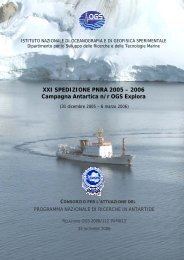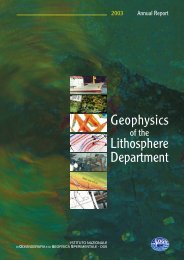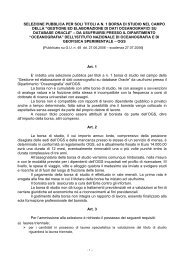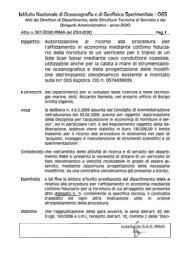Geophysical data acquisition - OGS
Geophysical data acquisition - OGS
Geophysical data acquisition - OGS
Create successful ePaper yourself
Turn your PDF publications into a flip-book with our unique Google optimized e-Paper software.
Orbitally-Controlled rhythmic sedimentation<br />
in the Wild Drift, Antarctica (ODP Leg 188, Site 1165)<br />
M. REBESCO<br />
This research, conducted in collaboration with J. Gruetzner (Bremen University,<br />
Germany) is an outcome of the participation of an <strong>OGS</strong> researcher (Michele<br />
Rebesco) to the ODP Leg 188 in Prydz Bay – Cooperation Sea (Antarctica). Leg 188<br />
cruise began in Fremantle (Australia) on 10 January 2000 and ended in Hobart<br />
(Australia) on 11 March 2000. Three sites were drilled on continental shelf, slope<br />
and rise to document onset and fluctuations of East-Antarctic glaciations.<br />
Site 1165 is situated in a water depth of 3357m on the continental rise in front of<br />
the outlet of the Lambert glacier-Amery Ice Shelf system that today drains 22% of<br />
East Antarctica. The site cored a 999-m lower Miocene-Holocene section into an<br />
elongate sediment body (Wild Drift) formed by the interaction of westward-flowing<br />
currents with the sediment supplied from the shelf. Alternations with wavelengths<br />
ranging from cm to m size between a greenish grey diatom bearing clay facies and<br />
dark grey clay facies with silt laminations are apparent throughout the hole back<br />
to early Miocene time. Furthermore the greenish intervals are characterised by<br />
lower density, susceptibility and iron content. The dark grey intervals are<br />
interpreted as contouritic facies deposited during maximum ice advances whereas<br />
the greenish sediments indicate hemipelagic sedimentation under warmer climate<br />
conditions.<br />
Analysis of high resolution colour photo-spectrometer <strong>data</strong> reveals that the colour<br />
cycles are best described by the ratio of the reflectivity in the green colour band<br />
and the average reflectivity (grey).<br />
Spectral analyses on depth and time series of the investigated parameters over<br />
selected intervals demonstrate that variance is dominated by orbital frequencies as<br />
predicted by the Milankovitch theory. The detected obliquity and precession cycles<br />
allow a refined evaluation of sedimentation rates.<br />
Subsidence at the Cape Roberts drill sites<br />
(Ross Sea, Antarctica) from backstripping techniques<br />
L. DE SANTIS<br />
G. BRANCOLINI<br />
The tectonic subsidence of the western margin of the Victoria Land basin has been<br />
estimated from the physical properties and ages of the sediments in the Cape<br />
Roberts Project drill cores 2/2A and 3, using backstripping techniques, assuming a<br />
local isostatic compensation. The sediment load effects is removed from the total<br />
subsidence and the tectonic contribution through time at each location is<br />
calculated.<br />
The analysis indicates a total tectonic subsidence of about 660 m at this location<br />
between 34 Ma and the present time. Two main trends are defined, i) about 230<br />
m/m.y. from 34 Ma to 32.5 Ma, and ii) about 23 m/m.y. from 32.5 Ma to 21 Ma.<br />
Since 21 Ma, the subsidence is not well constrained. Extrapolation indicates a very<br />
low subsidence rate, but uplift within this period may have greatly affected the<br />
estimate.<br />
42






